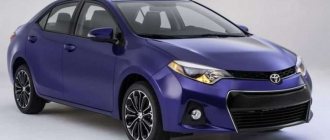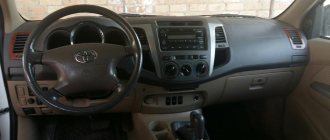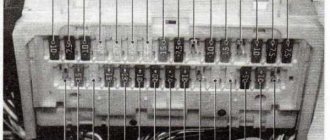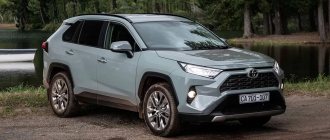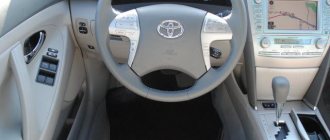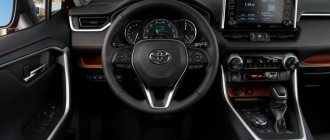Difference between E140 and E150
Corolla E140 in a simple configuration on top, E150 on the bottom (both pre-restyle)
Both the “one hundred and fortieth” and the “one hundred and fiftieth” belong to the same generation of Corolla. They both entered the market in the same year, and are similar in appearance, but there are nuances that make them considered different cars.
Both the Corolla E150 and E140 are X-generation Corolla cars produced for different markets. E150 is the 10th generation for Europe, E140 is designed for the American consumer. Hence the differences in technical content. The “American” was equipped with 1.8 2ZR-FE and 2.4 2AZ-FE engines, the European version received 1.4 and 1.6 liter engines.
The “one hundred and fiftieth” was equipped with an independent rear suspension and disc brakes. And the “one hundred and forty” received a beam and brake system options depending on the type of configuration. (in simple versions the rear brakes were drum, in expensive ones - disc).
The difference in chassis design is explained by the different architectural basis. The Corolla E140 is built on the Toyota MC platform, and the E150 is built on an updated version of this “trolley”, called Toyota New MC.
Optics E140 on top, E150 on bottom
Toyota E140 and E150 differ in optics. Cars for Americans were equipped with running lights and 2 reversing lights without fog lights. The European version was equipped with “foglights”, but with one lamp for the reverse gear signal and without running lights.
The difference in the exterior of the two cars is in the different radiator grilles. Before restyling, the E140 had a simple black one. The E150 2006 - 2010 has a more intricate grille, with two longitudinal lines. The difference is clearly visible in the photo.
E140 design
The external outlines of the 10th generation Toyota Corolla were influenced by its market affiliation. “American” received elements that give its appearance a touch of aggressiveness, in contrast to the soft lines of the European version.
Corolla E140 dorestyle XRS
The 10th generation Toyota Corolla has undergone updates. The 2010 restyling did not radically change the car both externally and internally. The updates affected the bumpers, radiator grille, the shape of the optics, rims and rear-view mirrors.
Corolla E140 XRS restyling
Appearance
The initial design of the Corolla 140 in simple configurations is unremarkable: simple shapes, classic lines and utilitarian solutions.
Regular Corolla E140 dorestyle
Externally, the European and American versions differed. The optics of the E140 differed from the E150 in orange dimensions, which are located in the upper corner of the headlight. The taillights also have minor differences. The European version has a wider part of the lamp, located on the trunk lid, and the location of the light elements is different. The radiator grilles are also different, which is clearly visible in the photo.
Feed E140 on top, 150 on bottom
The E140 body was available in the XRS package, which can be immediately distinguished from others by its spoiler, front and rear bumpers.
Salon
Salon of Corolla E 140 dorestyle
The interior of the Toyota Corolla and e140 and e150 can hardly be called ideal. The seats are not very comfortable, but roomy: 5 people including the driver can sit comfortably. The luggage compartment volume is expanded due to the transformation of the second row.
Dashboard Corolla E150 restyling
The quality of materials in the basic configuration is average, but there are no creaking parts, nothing bulges, and is adjusted to size. Leather trim is available for the tenth generation Corolla E140 as an option in expensive trim levels.
Dashboard Corolla E140 restyling
The dashboard of the American version is marked with miles. It is also distinguished by rigor and simplicity. In the European version, the tidy is bright, with orange markings and the same on-board computer screen, which adds visibility.
Salon of the restyled Corolla E140 in leather
The steering wheel has a thickened circle and a flat surface underneath. Moreover, it will not be easy to distinguish the E 140 steering wheel from the E150, but they are different. These minor differences are noticeable in the photo.
Corolla Axio: model features
In the Japanese domestic market, the tenth generation model is called Corolla Axio, which means “value” in Greek. At the same time, the sizes of the cars that were sold in Toyota’s homeland were smaller than those produced for export in order to comply with Japanese rules.
The design of both the exterior and interior of the car is devoid of bright details that could attract a curious eye. The model is just right for those for whom it was created - rational, decent and economical. This is exactly how Toyota developers imagine a car for every day. The gaze focuses only on the head optics, the brand name on the radiator grille, the rising line of the side glazing and the modest, but elegant brake lights in their own way.
In different trim levels, the Corolla Axio can be equipped with alloy wheels, fog lights, UV protection and xenon.
The interior design of the car, made using high-quality materials, has a very original look and offers several color options. The interior space has also undergone changes. Due to the fact that the body height was reduced by 10 mm, the seats were lowered lower, and the rear ones were moved back by 25 mm. Such changes have made the ride somewhat more comfortable for tall passengers.
The model's trunk, with a volume of 450 liters, can accommodate enough, but it will not be possible to transport cargo of non-standard sizes - the rear seats do not fold down at all.
The compact 4-door Sedan Corolla axio in the tenth generation is equipped with engines with a power of 105 or 110 horsepower, in which acceleration to hundreds of kilometers per hour takes a few moments. It is based on a slightly modified chassis from 2001, but the tenth generation model has a variable transmission instead of the usual and previously familiar “automatic”. This innovation helped strengthen the car's economical status. And for classic lovers there is a 5-speed manual transmission.
During its time on the market, Corolla axio has already been tested and evaluated by car enthusiasts, most of whom recommend a similar model for calm and novice drivers. No manufacturing defects have been found in the model so far. Minor shortcomings include insufficient sound insulation, the CVT is too noisy and the time required to warm up the engine is too long. Otherwise, this “Tenth” was and remains an example of Japanese quality and reliability.
Specifications
Under the hood of the Corolla 140
Toyota Corolla X has excellent reliability indicators compared to its competitors. There is a belief that owners of 10th generation cars visit a car service center only to replace consumables and undergo maintenance. But in fact, the E140 and E150, like all cars, require proper care. A conscientious owner of the Corolla will retain all technical characteristics at the same level. And if you don’t give a damn, the car will present a lot of unpleasant surprises.
Engines and transmissions
If you count the modifications of the 10th generation Toyota Corolla, then it was equipped with 11 engines, depending on the place of assembly and the market.
Engine 1.8 2ZR-FE Corolla E140
The American version of the E140 was equipped with an in-line 4-cylinder 16-valve gasoline engine 1.8 l 132 hp 2ZR-FE and 2.4 2AZ-FE with 158 horsepower. The 1.8-liter unit had a dual VVT-i system and was coupled with a four-speed automatic transmission and a 5-speed manual. Also installed with a 2.4 engine, 5-speed automatic transmission.
The 2.4 petrol 2AZ-FE unit with a dual VVT-i gas distribution system developed 158 horsepower and was considered the most powerful among all engines of the 10th generation Corolla. The engine was distinguished by its high service life, efficiency and durability, but was not in sufficient demand.
Therefore, the 2.4 2AZ-FE engine was not installed in the restyled Corolla E140.
For the European consumer (Corolla 150), the creators offered in the basic configuration a 1.4-liter gasoline engine with the index 4ZZ-FE, producing 97 horses, and a 1.6-liter 126 hp 1ZR-FE unit, equipped with a dual VVT-i system. Both engines were particularly robust and durable. With timely maintenance, the service life of these units is incredibly long.
Diesel engines were also offered for Europe: 1.4 90 hp 1ND-TV, 2.0 1FTV 126 horses.
Such units were not offered to Russian consumers, but were imported privately.
Consumption
Feed Corolla E140 XRS
Compared to its main competitors, 10th generation Toyota Corolla cars are considered economical, regardless of the installed engine. The developers also managed to ensure that on some versions the type of transmission does not affect fuel consumption. And it turns out that the most common 1.8 2ZR-FE engine with a manual transmission consumes 9 liters in the city, 6.7 liters per 100 km outside the city. The performance of the same 1.8 2ZR-FE engine with automatic transmission is no different. It also consumes about 9 liters in the city and 6.7 on the highway.
Corolla E140 XRS facelift
And the most powerful engine, the 2.4 2AZ-FE with a 5-speed manual transmission, consumes the same 9 liters in the city and about 7 on the highway. Although the same 2.4 2AZ-FE engine with an automatic transmission consumes more gasoline than with a manual transmission. In city mode, fuel consumption will be 11 liters, outside the city 8 liters per 100 km.
The fuel consumption of the base Corolla E150 1.4 liter engine is literally a few grams less. On a 100-kilometer stretch of highway it takes 5.7 liters, and in the city 8.9 liters.
The volume of the fuel tank, regardless of engine size, is 50 liters.
Parameters of Corolla in the E140 body
The Coroll140 body has dimensions: length 453.9 cm, width 176 cm, height 146.6 cm. The wheelbase is 2601 mm, and the ground clearance is 13 and a half cm.
Corolla E140 restyling
The wheel size depended on the engine modification and was 214/45 R17 on XRS trim levels with a 2.4 engine, and 205/55 R16 on E140 Corollas with a 1.8 engine.
The trunk volume is small - only 348 liters, but it compactly fits many small items. But oversized cargo cannot be transported in the luggage compartment. Although the second row is transformable, it does not fold completely.
Corolla Fielder: reboot
The new tenth-generation station wagon model retains its name Fielder, which translates as “field player” Toyota Corolla Fielder. Having appeared in 2000, the Fielder received a high body and a spacious trunk; six years later, both design and technical parameters were modified.
The car's parameters remained as impressive as in the initial version. The car has a fairly roomy trunk, a very spacious interior, in which, however, the ceiling is slightly lower than before, and an updated exterior. Thanks to the combination of fuel efficiency and other characteristics, the station wagon has taken its rightful place in the car market.
If desired and possible, you can add side airbags, an air conditioning filter capable of capturing even the smallest particles that pollute the air, a variator, a closed-turn monitor and an automatic power flow regulator for the headlights.
In total, you can count about 40 different versions of the Fielder with both automatic and manual transmission. The most common configuration is the simplest - equipped with a 1.5-liter engine, variable transmission and all-wheel drive transmission.
According to the owners, the car really fulfills all the tasks stated by the manufacturer, namely, it remains an economical, comfortable, safe and fairly affordable model for thousands of drivers. The Russians also appreciated both the brand and the model, especially the size of the luggage compartment, the behavior of the “horse” on the road and the convenience of everyone who gets into such a car, including the driver.
Safety
Salon of Corolla E140 refurbished
Based on the results of the crash test, where the Toyota Corolla e140 earned 5 stars, it can be argued that the developers were concerned about the life and health of motorists. Depending on the configuration there will be a different number of airbags. The basic version has a driver's seat, a front passenger seat, side airbags and curtains.
Crash test
During the tests, results were obtained for both pedestrians and child passengers. Both indicators are 4 stars.
Also, the American Corolla 2008 - 2013 had a standard set of electronic security systems.
Pros and cons
Second row Corolla 140
The advantages of the Corolla E140 are reliability and unpretentiousness. Power units have a long service life - 300-350 thousand km. Anti-corrosion treatment along with the paintwork of the body is quite resistant. If they joked about previous generations that components and mechanisms could survive the body of a car, this is not the case with X.
But there are also disadvantages. Despite the amazing unpretentiousness, the components and mechanisms of 10th generation machines do not tolerate dust. The brake system is the first to react to dust by sticking the pedal or premature wear of the pads. To avoid problems on the road, it is recommended to clean and lubricate components at least every 10 thousand km.
Folded second row seats of the 10th generation Corolla
As for the engine line, all gasoline units are durable. True, the most powerful 2.4 2AZ-FE should not be considered a plus, since it is difficult to repair. Although with proper maintenance this engine does not need it.
Powerful diesel engines also create problems for European consumers. Premature wear of parts and other breakdowns will very quickly limit their efficiency. Although the “indestructible” 1.4-liter diesel engine compensates for low power and weak dynamics with uninterrupted operation.
Everything reliable is simple. Everything is simple and reliable. Tenth generation Toyota Corolla (E140-150)
This year Toyota Corolla will celebrate its half-century anniversary. During this time, the Japanese produced 11 generations of the model, set up production at 17 factories and brought it to one and a half hundred markets. Today we will find out how unpretentious the previous generation car, known under the symbol E140-150, turned out to be. This sedan was sold in Russia for six years - from 2007 to 2013. It was supplied from England, Turkey and Japan.
If you hope for trouble-free operation of the tenth Corolla, exclude options with the MMT (MultiMode Transmission) robotic transmission from the list of contenders. In its “youth”, this simple unit frayed your nerves with its unnatural operating algorithm, and after 50,000 km it upset you with the fatal wear of the clutch and the vagaries of the electric drive actuator, which does not tolerate large temperature changes. Dealers reflashed the “brains, changed the control unit and clutches... It didn’t help! As a result, in 2010, the Russian office curtailed supplies of sedans with the ill-fated MMT transmission...
Five- (C50) and six-speed (C60) manual transmissions are much more reliable. The required maximum of preventive measures is timely renewal of transmission fluids. Otherwise no hassle. The bearings of the unit normally survive more than 200 thousand kilometers, the clutch is quite enough up to 100 thousand. At the same time, the drive shaft oil seals lose their tightness - a problem that is typical for transmissions not only of the Corolla, but also of many competitors. For example, in Hyundai-Kia “mechanics”, a similar ailment emerges much earlier.
The hero of the release is the tenth generation Toyota Corolla, known under the symbol E140-150. Such sedans were sold in Russia from 2007 to 2013
If you are not eager to press the clutch pedal, there is an alternative to the “robot”. Since 2009, cars for the Russian market received a reliable, but archaic four-speed Aisin U340E automatic from 1999. The life cycle of the box is almost eternal (250–300 thousand km). The main thing, again, is not to forget to change the transmission oil every 50–60 thousand km.
Timely replacement of engine oil is also important for the health of any of the Corolla engines. According to the importer's rules, Toyota cars are required to come for maintenance a third more often than usual. The service interval of the brand in Russia is 10,000 km, versus 15,000 or even 20,000 km, which is more common in our market. If the oil was indeed changed, observing the regulations, then such an engine will easily last hundreds of thousands of km, despite the aluminum block. True, but on forums they argue with foam at the mouth about the optimal level of lubricant viscosity. The manufacturer recommends 0W-20 or 0W-30 oil, while service technicians believe that the more viscous 5W-40 is better.
On the Russian market, the Corolla E140-150 was offered with three gasoline engines, but at the global level the model had, of course, more of them
The initial 1.4 engine (index 4ZZ-FE, 97 hp, 130 Nm) is reliable, but rarely appears in advertisements. There are only about 5% of similar Corollas on the market. This is because deliveries of this modification lasted just over a year - from 2007 to 2008, after which it was replaced by a unit with a funny volume of 1.33 liters (1NR-FE, 101 hp, 132 Nm). It can also be found under the hood of the eleventh generation Corolla, albeit infrequently. However, if you find it, feel free to decide. Despite its small volume, the engine demonstrates excellent service life.
Unlike cars with a 1.33-liter engine, you won’t have to catch a Corolla with a 1.6 engine with a net. The choice is great: more than 90% of cars have 124 horsepower and 157 Nm. Such sedans were sold both before and after restyling, but the newer the option you choose, the better.
To minimize risks, we would advise choosing cars after restyling in 2010, or better yet, copies of the final year of production, 2012
In specimens of the first two years, the pump often leaks, which can be fixed by tightening the drive belt, and at the same time ruining the generator bearings. Check to see if the previous owner did anything wrong. Closer to 100,000, early cars are characterized by an oil pressure sensor leaking at the seams. It wouldn’t hurt to carefully check the thermostat (around 3,000 rubles).
However, the vagaries of early cars were resolved on later copies, and the naturally aspirated 1.6 was not used to breaking down on a major scale: the mechanism of the VVT-i variable valve timing system (about 40,000 rubles assembled, but without work) is as reliable as a strong timing chain (10,000 rubles), capable of rewinding one and a half or even two hundred thousand km.
The five-door hatchback version of the Corolla received a new name Auris
Be prepared for the fact that a car older than 2010 with any of the engines may surprise you with an involuntary increase in speed. Although if the owner responded to the recall campaign, there should be no surprises. But it won’t hurt to know that the scandal with the sticking accelerator pedal is not a local problem with Camry from the American market, but a global illness that includes “our” Corollas.
The Corolla body adequately resists the formation of holes, but the paintwork tends to lose its presentation at the first opportunity: it is easily scratched, chipped, and fades. Over time, the “thawed spots” in the paint become covered with rust, and the image of a slob is complemented by peeling wiper arms and jammed headlight washers... The reason for the breakdown of the latter is dirt. Corolla is generally an amazing “clean” car. The brake system especially does not like dampness and dust. ABS sensors “die” from high humidity, and from exposure to abrasive, pads and discs “die” twice as fast. The only way out is to wash the mechanisms and lubricate the guides every 10,000 km. Under the pressure of dust, the power windows and the trunk door lock also begin to act up. True, other popular representatives of the C-segment also suffer from the latter disease.
The paintwork on the previous Corolla was rather weak: it scratched, chipped, and faded.
Sometimes the steering system also fails. The problem is the loss of contact in the electric power steering control unit, which is why the steering wheel fills with KrAZ heaviness. At first, restarting the engine saves the situation, but later you are guaranteed to have to invest in new “brains” (24,000 rubles) or at least solder the contacts in specialized workshops.
A more common problem with the steering mechanism is knocking. When diagnosing a potential purchase, be vigilant and make sure that the intermediate shaft splines are intact (12,000 rubles), which break due to vibrations at 50–70 thousand kilometers. After 80–100 thousand, things take a serious turn. A noticeable play appears due to wear in the connection with the gear of the electric motor of the amplifier (more than 50,000 rubles for the electric power steering unit). To ensure that you avoid serious consequences, choose machines from the latest batches: the design of the unit was finalized only at the end of production, in 2012.
Different configurations do not greatly affect the design and performance of the interior
A unique steering consumable is fluoroplastic bushings at the output of the rods. Officially, they cannot be replaced, although “garage” services have long learned to select suitable options and update them with little effort. It should be understood that the problem may turn out to be more serious and require replacement of the steering rack itself (at the dealer - more than 50,000 rubles), which, however, often lasts up to 180-200 thousand kilometers.
The chassis architecture is simple, as is the design of the entire machine. The front axle has McPherson struts, the rear axle has a semi-independent beam. From a chassis point of view, it’s also better to avoid early Corollas. Firstly, due to banal physical wear and tear. Secondly, on cars from the first batches, the support bearings of the front struts (8,000 rubles) do not last more than 50–60 thousand kilometers, and the bushings (about 1,000 rubles per piece) and struts (from 3,000 per piece) of the front stabilizers do not last more than 30– 40 thousand kilometers. But on the updated sedans, harder bushings were used, thanks to which the service life of the elements increased to 50–70 thousand kilometers.
There have never been any serious questions about the safety of the Corolla
Shock absorbers (on average 8,000 rubles each) withstand shock for 80–100 thousand kilometers. Wheel bearings are even more - 150 thousand each. And the record holders include ball joints (provided the boot is in good working order) and silent blocks that last up to 200 thousand kilometers.
It was numbers like these that formed the image of Toyota as a reliable car. And although models from the 2000s are not as durable as their predecessors from the 1990s (a general trend), Toyota still reserves a special leadership in maintaining residual value and is, not unreasonably, an example of reliability.
Estimated prices for Toyota Corolla (tenth generation, E140-150) (2007–2013)
| Year of issue | Cost (thousand rubles) |
| 2007–2008 | 399–450 |
| 2008–2009 | 400–463 |
| 2009–2010 | 425–560 |
| 2010–2011 | 530–650 |
| 2011–2012 | 580–678 |
| 2012–2013 | 600–750 |
| Average car price for the last month | 502 |
Estimated prices for original spare parts for Toyota Corolla (tenth generation, E140-150, 2007–2013)
| Spare part | price, rub. |
| Water pump (pump) | 6000–12 000 |
| Stabilizer bushings, pcs. | 500–1200 |
| Brake pads | 1900–2300 |
| Brake discs | 4500–5500 |
| Generator | 23 000–62 000 |
| Steering rack | 24 000–26 000 |
| Thermostat | 2500–4500 |


